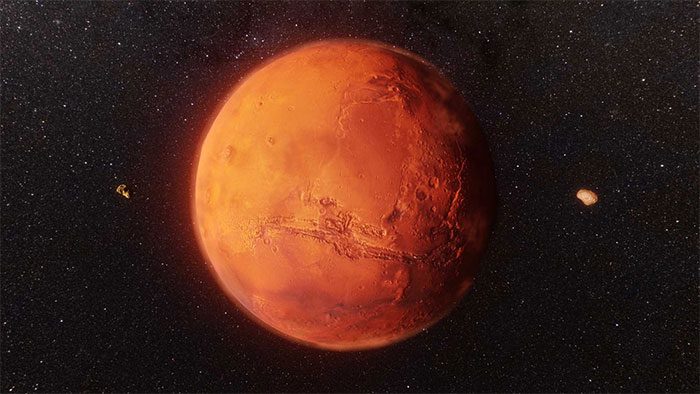According to new research, although Mars is about 225 million kilometers away from Earth, this planet is still influencing the climate where humans live.
As reported in a study published on March 12 in the journal Nature Communications, geological evidence dating back more than 65 million years, collected from hundreds of locations around the globe, indicates that deep-sea currents have undergone periods of strengthening and weakening multiple times. This phenomenon occurs every 2.4 million years and is referred to as the “Great Astronomical Cycle.”

Mars.
These stronger currents, known as giant eddies or vortices, can reach the deepest parts of the ocean called oceanic trenches. These powerful currents then erode large sediment deposits that accumulate during more stable periods within the cycle. The study also shows that these cycles coincide with times of gravitational interactions between Earth and Mars as the two planets orbit the Sun.
Co-author of the study, Professor of Geophysics Dietmar Müller stated: “The gravitational fields of the planets in the solar system interact with each other, and this interaction is called resonance, which alters the eccentricity of the planets and their orbits.”
Due to this resonance, Earth is pulled slightly closer to the Sun by Mars’ gravitational force, meaning our planet is exposed to more solar radiation, resulting in a warmer climate, before drifting back again in 2.4 million years.
The authors of the new study utilized satellite data to map sediment accumulation on the ocean floor over tens of millions of years. They discovered gaps in the geological record where sediment accumulation ceased during these astronomical cycles. They believe this may relate to stronger ocean currents, as the warmer weather is influenced by Mars’ gravitational pull on Earth.
These findings support the notion that, despite being hundreds of millions of years apart, Mars still affects climate on Earth. However, the authors also emphasize in their statement that this observed warming effect is not related to the global warming phenomenon caused by human greenhouse gas emissions.
Although still speculative at this stage, the findings suggest that the aforementioned cycles may periodically help sustain certain deep ocean currents, particularly if global warming causes them to diminish.
Professor Müller remarked: “We know there are at least two distinct mechanisms contributing to the strength of deep ocean mixing.” He mentioned that one of these mechanisms is known as the Atlantic Meridional Overturning Circulation (AMOC) – the main current system in the North and South Atlantic that plays a crucial role in the climate system. It operates like a “conveyor belt” beneath the ocean, transporting warm water from the tropics to the Northern Hemisphere.
Adriana Dutkiewicz, the lead author of the study and a sediment researcher at the University of Sydney, stated: “The deep-sea data over 65 million years that we have shows that warmer oceans have stronger circulation at depth, preventing stagnation in the ocean even when the Atlantic Meridional Overturning Circulation slows down or completely stops.”


















































